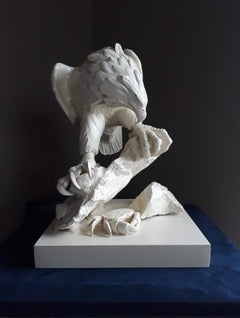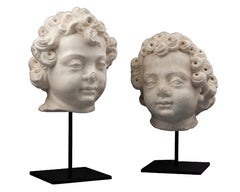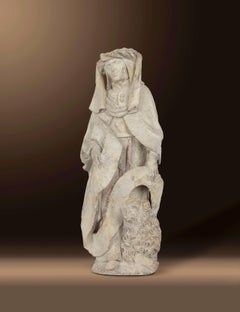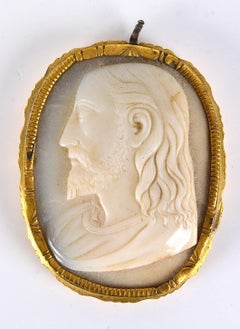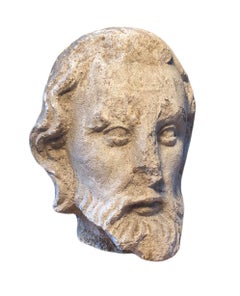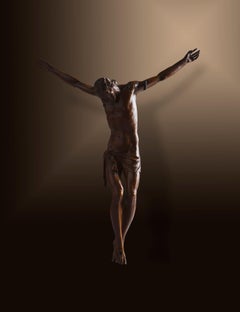16th Century Figurative Sculptures
to
1
24
3
12
8
3
4
Overall Height
to
Overall Width
to
1
21
13
13
11
9
7
5
4
4
3
3
2
1
1
1
1
1
1
1
1
198
497
2,008
8,873
46
45
77
111
53
122
129
167
228
273
55
12
8
6
6
6
Period: 16th Century
Lion
Located in Oswestry, GB
This artwork is described beautifully by Art critic and curator Salvatore Russo at an exhibition in Uffizi Gallery, Florence 2016 - "Barry Davies, a sculptor able to state the streng...
Category
Renaissance 16th Century Figurative Sculptures
Materials
Bronze
White tailed sea eagle and crab
Located in Oswestry, GB
This white tailed sea eagle is depicted here on a rock on the shore of a remote wild Scottish Isle (Outer Hebrides). Hiding beneath the rock is a brown crab...
Category
Baroque 16th Century Figurative Sculptures
Materials
Bronze
A 16th century Renaissance North Italian marble heads of two puttis
Located in PARIS, FR
Lovely pair of heads of small cherubs carved in white Carrara marble.
The chubby faces adorned with admirable hair with abundant tight and deep curls with a quiff on the forehead.
Th...
Category
Renaissance 16th Century Figurative Sculptures
Materials
Marble
Hl. Hieronymus
Located in Wien, Wien
St. Jerome
347 Stridon, Croatia - 420 Bethlehem
Around 1500/20
Limestone
Remains of the original polychromy
Height 45 cm
The man with the holy name!
347 Stridon, Croation – 420 Be...
Category
16th Century Figurative Sculptures
Materials
Limestone
16th Century Cameo Pendant of Christ the Redeemer in a Gilt Bronze Frame
Located in Stockholm, SE
A finely carved 16th or early 17th century large hard stone pendant cameo of Christ the Redeemer in profile. Set in period a gilt bronze frame. Possibly Italian.
The profile view of...
Category
Italian School 16th Century Figurative Sculptures
Materials
Precious Stone
LARGE ITALIAN RENAISSANCE MARBLE CAPITAL, 15th/16th Century
Located in Milan, IT
LARGE ITALIAN RENAISSANCE MARBLE CAPITAL
Florence, 15th/16th Century
marble
38 x 47 x 47 cm
15 x 18 1/2 x 18 1/2 in
Category
16th Century Figurative Sculptures
Materials
Marble
ITALIAN RENAISSANCE MARBLE RELIEF WITH GRIFFIN
Located in Milan, IT
ITALIAN RENAISSANCE MARBLE RELIEF WITH GRIFFIN Central Italy, 16th Century
marble
42 x 28.5 x 5.5 cm
16 1/2 x 11 1/4 x 2 1/4 in
Category
16th Century Figurative Sculptures
Materials
Marble
Saint Barbara France 16/17th Century Sculpture Wood Religious Old master Art
Located in Riva del Garda, IT
High relief panel depicting 'Saint Barbara'
Southern France, 16th-17th century
Polychrome carved wood with traces of gilding
64 x 32 cm.
(good condition, with minor missing and cra...
Category
Old Masters 16th Century Figurative Sculptures
Materials
Wood, Wood Panel
Virgin and Child
Located in Wien, Wien
OUTSTANDING MADONNA
Bavaria
Around 1515/20
Lime wood carved
Original, polychrome version
Height 60 cm
This masterfully carved, full-round Madonna was created around 1515-20 in...
Category
Medieval 16th Century Figurative Sculptures
Materials
Wood
A Spanish Statue of the Virgin Mary with Child Jezus, circa 1600
Located in Bruges, BE
Description: A Spanish Statue of the Virgin Mary with Child Jezus, Circa 1600, polychromed wood
Statue : Madonna and Child
Object Type: Statuette
Artist, Sculptor / Maker: Unknown
Place of Origin: Spain
Period: Circa 1600
Materials and Techniques: Polychromed wood
Categories: Christianity
Style: Renaissance
Dimensions: H. 45 cm D. 13 cm W. 15 cm
History:
The Madonna and Child is one of the most easily recognisable, most frequently produced themes in the history of Art and has been depicted by many famous artists, including Michelangelo, Leonardo da Vinci, and Raphael.
The word Madonna is derived from the Italian 'ma donna,' or 'my lady' and is used to describe Mary, the mother of Christ.
The Madonna and Child depict a loving mother and son, which is a symbol of hope, faith, and love and represents the love and bond between mother and child, and is a symbol of hope and protection.
Physical Description:
A magnificent statue in polychromed wood of standing Madonna and Child. Virgin Mary is holding Her Son in Her left arm. Together with Jesus Christ They are holding the World in Their hands to show that They are together and our Heavenly king on Earth and His Mother is our Queen.
She wears a tight fitting golden red dress; over this is a red mantle; Her mantle is lined blue and is with an ochre gold border. The flesh is painted in natural colours and Her long hair lies over both shoulders.
The Child Jesus wears a green long sleeves dress. With His right hand He gives a blessing and represents Trinitarian love. In addition to signifying a blessing or that the Lord is speaking, this position conveys doctrinal truth, the three uplifted fingers depict the unity of God in the Holy Trinity (Father, Son, and Holy Spirit).
Historical Significance:
The facial features and drapery which envelopes the body point to Spanish origin. The statue of Virgin Mary...
Category
Renaissance 16th Century Figurative Sculptures
Materials
Wood
Antique Bust of Roman Emperor Vitellius
Located in Newport Beach, CA
Substantial, hand carved, solid marble bust of Roman Emperor Vitellius (24-69 C.E.) on a custom, iron base. Likely a 16th century copy of a 2nd century o...
Category
16th Century Figurative Sculptures
Materials
Marble
Medieval Style Carved Statue of 3 Religious Figures
Located in San Antonio, TX
Medieval style carved sculpture of three religious figures, possibly saints. The sculpture is in the style of Gothic religious art from continental Europe, particularly Germany and F...
Category
Realist 16th Century Figurative Sculptures
Materials
Wood
16th century Italian carved wood sculpture - Saint Robert - Gilded Painted
Located in Varmo, IT
Carved wooden sculpture - San Roberto. Italy, 16th century.
54 x 30 x h 112 cm.
Entirely in carved and painted wood with traces of polychromy and gilding.
- Work inscribed on the ...
Category
Renaissance 16th Century Figurative Sculptures
Materials
Paint, Wood
16th century Italian carved wood sculpture - Saint Mauritius - Gilded Painted re
Located in Varmo, IT
Carved wooden sculpture - San Mauro. Italy, 16th century.
54 x 30 x h 110cm.
Entirely in carved and painted wood with traces of polychromy and gilding.
- Work inscribed on the bas...
Category
Renaissance 16th Century Figurative Sculptures
Materials
Paint, Wood
Laocoön And His Sons By Adriaen De Vries
Located in New Orleans, LA
Adriaen de Vries
1556-1626 Dutch
Laocoön and His Sons
Bronze
A remarkable feat of artistry and skill, this bronze sculpture was created by famed Dutch artist Adriaen de Vries. Full of the swelling emotions and dramatic posing so quintessential to the period, the bronze is a masterclass in Baroque sculpture.
The original Laocoön marble sculpture, after which this remarkable bronze was modeled, unquestionably influenced the lives and works of countless artists, authors, popes, kings and emperors since its re-discovery in 1506. Famously, Michelangelo declared the sculpture, created circa 35 BC, as the “greatest piece of art in the world.” Adriaen de Vries, an apprentice of the great sculptor Giambologna, undoubtedly sought to prove his skill and creative voice with his own depiction of this most famous scene. Known for his virtuosic casting technique, this rare and important sculpture embodies de Vries’ mastery.
The story of Laocoön is one of the most famous in all of literature. As told by the poet Virgil, the Greeks, after an unsuccessful ten-year siege on the city of Troy, the Greeks craftily left a giant wooden horse outside the gates...
Category
Baroque 16th Century Figurative Sculptures
Materials
Bronze
Anatomical study of a lion
Located in Oswestry, GB
This artwork is described beautifully by Art critic and curator Salvatore Russo at an exhibition in Uffizi Gallery, Florence 2016 - "Barry Davies, a sculp...
Category
Northern Renaissance 16th Century Figurative Sculptures
Materials
Bronze
16th C Mechelen Doll with letter M carved in the back.Some leftovers of polychro
Located in brussel, BE
Mechelen dolls are rare wooden devotional figurines (mainly walnut was used), which were made by some members of the Guild of Saint Luke. The figures, all individual saints, were made from reference models using highly regulated carving and polychrome techniques. They had to meet several requirements. The shape of the rug had to meet certain criteria and the letter M (from Mechelen) had to be visible in the shape. These devotional or saint figurines...
Category
16th Century Figurative Sculptures
Materials
Wood, Driftwood
Pair Flying Angels
Located in Wien, Wien
MUSEUM PAIR FLYING ANGELS
Brabant/Brussels
Around 1500
Oak wood, full round carved
Height 40/38 cm
These two figures are a pair of flying angels mad...
Category
16th Century Figurative Sculptures
Materials
Oak, Wood
Important Sculpture
Located in ROUEN, FR
"Important Sculpture
IMPORTANT SCULPTURE representing Saint Floran de Lorch in polychrome wood in its beautiful old polychromy. He is represented ...
Category
16th Century Figurative Sculptures
Materials
Wood
Sheath In Sea Green And Red Marble From Caunes-minervois Nineteenth
Located in ROUEN, FR
"Sheath In Sea Green And Red Marble From Caunes-minervois Nineteenth"
Marble green sea for the central part and surrounded by a red of Caunes-Minervois XIXè. Provenance:GalerieParisi...
Category
16th Century Figurative Sculptures
Materials
Marble
Master Angel
Located in Wien, Wien
MASTER ANGEL
Museum sculpture of the master of Mauer
Austrian Danube Region
Around 1500/20
Lime wood, carved full round
Height 55 cm
Provenance:
Hofstätter Collection, Vienna
The masterful sculpture was made in the workshop of the master of the altar of Mauer around 1500 in Lower Austria. It can be located in the context of the Danube school of the first third of the 16th century, was carved from limewood and is 55 cm tall. Since there are no attributes or context, it is an unknown figure of a carved altar.
The master of the altar of Mauer is an anonymous Gothic carver who was active between 1500 and 1525 and received this so-called emergency name through the altar for the parish and pilgrimage church of Mauer near Melk. This winged altar was probably commissioned by Göttweig Abbey in the 1470s and is made of lime wood. It shows an expression in the transition from late Gothic to early Renaissance and is considered the most important carved altar in Lower Austria, created between 1510-15.
The figure presented here is very related in its design to the figures of the altar of Mauer. In lively-moving form, the male figure turns his upper body to the right, with his head pointing upward, probably toward the sky. The right leg in lunge emerges from under the frock...
Category
16th Century Figurative Sculptures
Materials
Wood
Saint Sebastian Lombard school. Italian Renaissance Carved alabaster.
Located in PARIS, FR
Large Saint Sebastian finely carved in alabaster. The saint is attached to a column surmounted by a capital, beautiful soft features and superb hair wi...
Category
Renaissance 16th Century Figurative Sculptures
Materials
Stone, Alabaster
Late Gotic Relief "Adoration of the Magi"
Located in Wien, Wien
LATE GOTIC RELIEF “Adoration of the Magi
Lower Rhine
Around 1500
Oak wood, plastically carved
Original, polychrome version
Height 51 cm, widt...
Category
Gothic 16th Century Figurative Sculptures
Materials
Wood, Oak
16th Century Venetian bronze sculpture of a Young Man in Armour
Located in Milan, IT
16th Century Venetian bronze sculpture of a Young Man in Armour attributed to the Florentine artist Andrea di Alessandri, called Il Bresciano (Fl...
Category
16th Century Figurative Sculptures
Materials
Bronze
ANTIQUE ITALIAN RENAISSANCE IONIC MARBLE CAPITAL WITH PUTTI, 16TH CENTURY
Located in Milan, IT
Finely carved male capital dated from the 16th Century. Created in Italy, this fine works features the faces of winged cherubs.
Category
Renaissance 16th Century Figurative Sculptures
Materials
Marble
ITALIAN BRONZE FIGURE OF YOUNG CHERUB ON PORPHYRY BASE - ATT. TO ROCCATAGLIATA
Located in Milan, IT
Resting on a circular Egyptian porphyry base, this fascinating bronze figure of a young cherub is a striking example of the Venetian workmanship of the 16th Century. With the head tu...
Category
16th Century Figurative Sculptures
Materials
Bronze
Hand Carved Wooden Frame, 16th Century European School
Located in London, GB
Hand Carved Fruit Wood
Length: 16 inches (40.5 inches)
A striking, richly hand carved frame in high relief. It shows a rich decor of natural organic forms alongside a collection of ...
Category
16th Century Figurative Sculptures
Materials
Wood
Related Items
Gothic head of an apostle - 13th century
Located in PARIS, FR
Head of apostle or Christ in carved limestone. Elongated face with a large forehead and long hair with thick wavy locks on the sides.
The almond-shaped eyes are underlined by the hem...
Category
Gothic 16th Century Figurative Sculptures
Materials
Limestone
Roman 18th century terracotta model for the sculpture of San Camillo de Lellis
Located in London, GB
This remarkably fluid terracotta bozetto was made in preparation for Pietro Pacilli’s most important public commission, a large-scale marble statue of San Camillo de Lellis for the nave of St Peter’s Basilica in Rome. Expressively modelled, this terracotta sculpture is a rare and significant work made by a major Roman sculptor at a transformative moment of European sculpture. Pacilli began his working life on the great Baroque decorative projects initiated in the seventeenth century, but he found success as a restorer of ancient sculpture working to finish antiquities for a tourist market, becoming an important figure in the emergence of an archaeologically minded Neoclassicism. Pacilli trained Vincenzo Pacetti and provided important decorative work for the Museo Pio-Clementino, at the same time he is recorded restoring some of the most celebrated antiquities excavated and exported during the period.
Pacilli was born into a family of Roman craftsmen, his father Carlo was a wood carver, and Pacilli is recorded working with him on the Corsini Chapel in San Giovanni Laternao as early as 1735. In 1738 his terracotta model of Joseph and Potiphar’s Wife won the first prize in the second class of the sculpture concorso at the Accademia di San Luca, this is particularly notable as Bartolomeo Cavaceppi came third. He worked as a carver and stuccoist completing works for the churches of San Marco and SS. Trinita dei Domeniciani Spagnoli. Pacilli operated as a sculptor and restorer of antiquities from his studio at the top of the Spanish Steps, close to Santa Trinita dei Monti, where he is listed as a potential vendor to the Museo Pio-Clementino in 1770.
In 1763 Pacilli completed a silver figure of San Venanzio for the treasury of San Venanzio. He is recorded as Pacetti’s first master and it was evidently through Pacilli that he began to acquire his facility as a restorer of ancient sculpture. Pacilli, at his studio ‘poco prima dell’Arco della Regina alla Trinita dei Monti,’ exercised, what the nineteenth-century scholar, Adolf Michaelis called ‘rejuvenating arts’ on several important pieces of classical sculpture, including in 1760 the group of a Satyr with a Flute for the natural brother of George III, General Wallmoden, Hanovarian minister at Vienna. In 1765, Dallaway and Michaelis record that Pacilli was responsible for the restorations, including the addition of a new head, to the Barberini Venus which he had acquired from Gavin Hamilton. The Venus was then sold to Thomas Jenkins, who in turn passed it on to William Weddell at Newby Hall. In 1767 Pacilli exported a series of ancient busts ‘al naturale’ including portraits of Antinous, Julius Ceaser and Marus Aurelius, also a statue of a Muse and a Venus. As early as 1756 Pacilli seems to have been operating as an antiquarian, helping to disperse the collection of the Villa Borrioni. Pacilli supplied sculpture to notable British collectors, including Charles Townley, who on his first trip to Italy purchased the Palazzo Giustiniani statue of Hecate from Pacilli. Pacilli was involved with the Museo Pio Clementino from its conception, supplying busts of Julius Ceaser and a Roman Woman as well as completing stucco putti surmounting the arms of Pope Bendedict XIV to signal the entrance to the new Museo Critiano.
In 1750 Il Diario Ordinario del Chracas announced that Pacilli had begun work on a sculpture of San Camillo de Lellis for St Peter’s. Camillo de Lellis founded his congregation, the Camillians, with their distinctive red felt crosses stitched on black habits in 1591. Having served as a soldier in the Venetian army, Camillo de Lellis became a novitiate of the Capuchin friars, he moved to Rome and established a religious community for the purpose of caring for the sick. In 1586 Pope Sixtus V formerly recognised the Camillians and assigned them to the Church of Santa Maria Maddalena in Rome. Camillo de Lellis died in 1614 and was entombed at Santa Maria Maddalena, he was canonised by Benedict XIV on June 26, 1746. It was an occasion that prompted the Camillians to make a number of significant artistic commissions, including two canvases by Pierre Subleyras showing episodes from San Camillo’s life which they presented to Benedict XIV. In 1750 Pacilli was commissioned to fill one of the large niches on the north wall of the nave with a sculpture of San Camillo.
The present terracotta bozetto presumably had two important functions, to enable Pacilli to work out his ideas for the finished sculpture and at the same time to show his design to the various commissioning bodies. In this case it would have been Cardinal Alessandro Albani and Monsignor Giovan Francesco Olivieri, the ‘economo’ or treasurer of the fabric of St Peter’s. Previously unrecorded, this terracotta relates to a smaller, less finished model which has recently been identified as being Pacilli’s first idea for his statue of San Camillo. Preserved in Palazzo Venezia, in Rome, the terracotta shows San Camillo with his left hand clutching his vestments to his breast; the pose and action more deliberate and contained than the finished sculpture. In producing the present terracotta Pacilli has expanded and energised the figure. San Camillo is shown with his left hand extended, his head turned to the right, apparently in an attempt to look east down the nave of St Peter’s. The model shows Pacilli experimenting with San Camillo’s costume; prominently on his breast is the red cross of his order, whilst a sense of animation is injected into the figure through the billowing cloak which is pulled across the saint’s projecting right leg. The power of the restrained, axial contrapposto of bent right leg and outstretched left arm, is diminished in the final sculpture where a baroque fussiness is introduced to the drapery. What Pacilli’s terracotta demonstrates, is that he conceived the figure of San Camillo very much in line with the immediate tradition of depicting single figures in St Peter’s; the rhetorical gesture of dynamic saint, arm outstretched, book in hand, head pointed upwards was perhaps borrowed from Camillo Rusconi’s 1733 sculpture of St. Ignatius...
Category
Baroque 16th Century Figurative Sculptures
Materials
Terracotta
The Philosopher
Located in PARIS, FR
The Philosopher
by Vincenzo Gemito (1852-1929)
Bust in bronze with a nuanced dark brown patina
Signed "Gemito"
Stamped with the foundry mark "Fonderia Gemito Napoli - Merca di Fabbr...
Category
Italian School 16th Century Figurative Sculptures
Materials
Bronze
PAX (BETWEEN TIMES) - Geometric Sculpture Vintage Salvaged Building Materials
Located in Signal Mountain, TN
Brian Russell Jobe (American, b. 1981) is an artist and non-profit director based in Knoxville, Tennessee.
Jobe's studio practice is focused on sculptur...
Category
Contemporary 16th Century Figurative Sculptures
Materials
Concrete, Marble
H 12.75 in W 17.75 in D 7.5 in
Vintage Peacock I (Wall Piece/Dish) (MADE TO ORDER) (~50% OFF LIMITED TIME ONLY)
Located in Kansas City, MO
(MADE TO ORDER) (Hand-painted, hand-made, porcelain)
*Lead Time may vary between 1-3 weeks
Melanie Sherman
Vintage Peacock I (Wall Piece/Dish (handpainted)
Porcelain, Glaze, Overglaze, Chinapaints, 24k German Gold Luster, Brass Wire (for hanging, can be removed)
Year: 2022
Size: 4.5x6x0.5in
Signed by hand
COA provided
Ref.: 924802-1330
------------------------
My ceramics are handmade and painted with the finest overglazes from Europe. The gold luster used is 24k liquid Gold from Germany. Every piece is unique. My imagery is inspired by vintage Meissen dinnerware...
Category
Baroque 16th Century Figurative Sculptures
Materials
Brass
Workshop Benedetto Boschetti Grand Tour Marble Model Of Bath With Ferine Feet
Located in Roma, IT
A Giallo Antico (Giallo Numidia ) marble grand tour model of a bath with ferine feet standing on a squared Violet Marble two order base. The work from the workshop of Benedetto Bosch...
Category
Other Art Style 16th Century Figurative Sculptures
Materials
Marble
H 3.55 in W 6.7 in D 3.55 in
Vintage Peacock III (Wall Piece/Dish (hand-painted, made to order by the artist)
Located in Kansas City, MO
Melanie Sherman
Vintage Peacock III (Wall Piece/Dish (handpainted)
Porcelain, Glaze, Overglaze, Chinapaints, 24k German Gold Luster, Brass Wire (for hanging, can be removed)
Year: 20...
Category
Baroque 16th Century Figurative Sculptures
Materials
Brass
Antique French Gilt Bronze Marble Statue Sculpture of Fortuna Louis G Fulconis
Located in Portland, OR
A very good large antique French gilt bronze of the Roman goddess Fortuna, by Louis Guillaume Fulconis (1818-1873), circa 1860.
The bronze is inspired by sculpture of the Italian Ren...
Category
Renaissance 16th Century Figurative Sculptures
Materials
Bronze
Early 19th Century Italian School Bronze, The Borghese Gladiator, c. 1810
Located in Beachwood, OH
Early 19th Century Italian School
The Borghese Gladiator, c. 1810
Bronze with green patination
27 x 18 x 26 inches
Since its discovery in the early seventeenth century, the Borghes...
Category
Italian School 16th Century Figurative Sculptures
Materials
Bronze
H 27 in W 18 in D 26 in
Grand Tour Bronze Sculpture of Dionysus, 19th Century Italian School
Located in Beachwood, OH
19th Century Italian School
Grand Tour Bronze Sculpture of Dionysus, 19th Century
Bronze with black-green patination
24 x 10 x 10 inches
Dionysus, in Greco-Roman religion, a nature ...
Category
Italian School 16th Century Figurative Sculptures
Materials
Bronze
Terracotta figurativa italiana a tema mitologico dei primi del Novecento
Located in Florence, IT
Piccola terracotta a soggetto mitologico firmata sul retro sulla base "Zambini", che per la grafia (in particolare la Z che ricorda una F) permette di identificare l'artista con Ferr...
Category
Renaissance 16th Century Figurative Sculptures
Materials
Terracotta
A Flemish Statue of Crowned Virgin Mary with Child Jesus, 17th Century
Located in Bruges, BE
Description: A Flemish Statue of Crowned Virgin Mary with Child Jesus, 17th Century, polychromed wood, silver crowns
Statue: Crowned Madonna and Child
Object Type: Statuette
Artist, Sculptor / Creator: Unknown
Place of Origin: Flanders
Period: 17th Century
Style: Renaissance
Materials and Techniques: Polychromed wood, Silver
Categories: Christianity
Dimensions: H. 55 cm D. 15 cm W. 19 cm
History:
The Madonna and Child is one of the most easily recognisable, most frequently produced themes in the history of Art and has been depicted by many famous artists, including Michelangelo, Leonardo da Vinci, and Raphael.
The word Madonna is derived from the Italian 'ma donna,' or 'my lady' and is used to describe Mary, the mother of Christ.
The Madonna and Child depict a loving mother and son, which is a symbol of hope, faith, and love and represents the love and bond between mother and child, and is a symbol of hope and protection.
Purity or virginity is represented by the color of clothing of Madonna. The color blue symbolises purity, virginity, and royalty.
Physical Description:
A magnificent 17th Century statue in polychromed wood of standing Madonna and Child. Virgin Mary is holding a small staff that is often shown in the hands of a king or queen. In Her left arm She is holding Her Son, Jesus Christ who is holding the World in His left hand to show that He is our Heavenly king on Earth and His Mother is our Queen. She wears a tight fitting golden dress with blue sleeves; over this is a blue mantle; Her mantle is lined red and is with an ochre gold border. The flesh is painted in natural colours and Her long hair lies over both shoulders.
The Child Jesus wears a blue long sleeves dress...
Category
Renaissance 16th Century Figurative Sculptures
Materials
Wood
H 21.66 in W 7.49 in D 5.91 in
Previously Available Items
Corpus Christi
Located in Wien, Wien
Corpus Christi
Perimeter Guglielmo della Porta
Porlezza 1500 - 1577 Rome
Italy or South German
2nd half 16th century
Boxwood
Height 20 cm
Category
16th Century Figurative Sculptures
Materials
Wood
Circle of Hans Sixt von Staufen
Located in Wien, Wien
HANS SIXT VON STAUFEN
Perimeter
"Birth of Christ"
Upper Rhine
Around 1520
Wood relief
Length 58 cm, height 50 cm,
Depth 18 cm
This museum relief can be attributed to the circle of the late Gothic master sculptor Hans Sixt von Staufen, who demonstrably worked from about 1515 to 1532, this being evident from archival evidence. In Staufen he probably ran a workshop, influenced by the carvings of the Würzburg School. He was probably also familiar with works by Tilmann Riemenschneider (ca. 1460-1531), who elaborately executed the surfaces in a similar manner.
The Holy Family is depicted in the foreground: Mary and Joseph frame the baby Jesus lying on Mary’s cloak. Between them are shown two figures in religious habitus, greatly reduced in size in meaning, who are possibly to be identified as the donors of the relief. Behind it, the ox and donkey look down on the central action from behind the fence of the stable...
Category
16th Century Figurative Sculptures
Materials
Wood
Relief of a rare Representation
Located in Wien, Wien
RELIEF OF A RARE REPRESENTATION
"The Visitation od. Meeting of the two
pregnant women Maria & Elisabeth"
Bavaria
Around 1500
Lime wood carved in relief
Remains of the original ...
Category
16th Century Figurative Sculptures
Materials
Wood
St. Sebastian around 1500
Located in Wien, Wien
REMARKABLE SCULPTURE
“St. Sebastian”
Tyrol/South Tyrol
Around 1500
Lime wood carved
Remains of the original polychromy
Height 70 cm
The figure of Saint Sebastian (70 cm) was made in the Alpine region around 1500. The naked youth is depicted with typical golden loincloth and a rare high hat as well as tied to a tree trunk. His stigmata on arms, torso and legs are exposed, the arrows with which he was pierced are not preserved here. Sebastian served as an officer for Emperor Diocletian and was martyred for his Christian faith: he was tied to a tree where he was shot by numerical archers. Since he was thought to be dead, he was left behind; however, the arrows had not been able to kill him. A benefactress named Irene nursed him back to health; later, Sebastian again appeared before the emperor, who finally had him whipped to death and thrown into the Cloaca Maxima, Rome’s sewer. The nature of the martyrdom, as well as the marks left behind, place his martyrdom in the following of Christ.
The youthful body of the martyr is slightly bent; his right hand above his head and his left hand behind his back tied to the tree. The most distinctive feature is the high hat, which may represent a piece of armor. This hat is found especially in southern German/alpine Sebastian depictions of the late Gothic period. His detailed curls are hidden under the headgear; the face with half-open eyes, high cheekbones and slightly open mouth looks upwards in rapture. In French Burgundy, similar sculptures were created with softly modeled bodies and clinging loincloths; however, the boyish figure of Sebastian is also related to Donatello’s David...
Category
16th Century Figurative Sculptures
Materials
Wood
Late gothic Relief "Adoration of the Child in the stable at Bethlehem"
Located in Wien, Wien
LATE GODLY RELIEF “Adoration of the Child in the stable at Bethlehem”.
Lower Rhine
Around 1500
Oak wood, plastically carved
Original, polychrome versi...
Category
Gothic 16th Century Figurative Sculptures
Materials
Oak
Free Shipping
H 20.08 in W 19.69 in
16th century French wood sculpture - Saint figure - Carved oak Gothic
Located in Varmo, IT
Bas-relief sculpture (France, 16th century) - Evangelist.
60 x 23 cm.
Entirely in finely carved oak wood.
Condition report: Good state of conservation of the sculptural work, ther...
Category
Renaissance 16th Century Figurative Sculptures
Materials
Wood
Free Shipping
H 23.63 in W 9.06 in
Pair of Italian 16th Century marble wings
Located in Milan, IT
Pair of 16th Century marble wings that once belonged to a larger sculpture, probably a winged putto.
Category
16th Century Figurative Sculptures
Materials
Marble
Polychrome Altarpiece. Entombment of Christ.
Located in PARIS, FR
Beautiful altarpiece element in polychrome limestone depicting the Entombment and depicting 6 characters surrounding Christ. Joseph of Arimathea and Mary are depicted at his bedside.
This piece is distinguished by the presence of 6 personages instead of the traditional 7, John beardless and seated is present, as well as Nicodemus, one of the 3 holy women (Marie Madeleine, Marie Salomé and Marie Cléophas) is absent from the scene. .
This piece has retained its original polychromy, retouching and restorations.
Bibliography: La Statuaire de la Mise...
Category
Gothic 16th Century Figurative Sculptures
Materials
Limestone
Free Shipping
H 11.82 in W 14.57 in D 4.73 in
Marble Circular Relief depicting Alexander the Great as Hercules 16th Century
Located in Milan, IT
A marble roundel depicting Alexander the Great as Hercules wearing the lion's skin. Created in the 16th Century, this fine relief is a wonderful example...
Category
16th Century Figurative Sculptures
Materials
Marble
Italian Bronze Little Sculpture, Italy, 16th Century, Venetian Renaissance
Located in Varmo, IT
Burnished bronze table sculpture on plexiglass base. "Cherub". Italy, 16th century.
Category
Renaissance 16th Century Figurative Sculptures
Materials
Bronze
Free Shipping
H 2.37 in W 4.73 in D 2.37 in
FRENCH OR ITALIAN SECOND HALF 16TH CENTURY MARBLE BUST OF A BOY
Located in Calabasas, CA
FRENCH OR ITALIAN SECOND HALF 16TH CENTURY
A WHITE MARBLE AND WHITE-AND-GREY STRIATED RED MARBLE BUST OF A BOY
The drapery possibly associated
Fine Fren...
Category
Renaissance 16th Century Figurative Sculptures
Materials
Marble
Free Shipping
H 18 in W 11 in D 6.5 in
Virgin Child Flemish Renaissance 16th Century Art Wood Flandre Old master Maria
Located in Riva del Garda, IT
Wooden sculpture representing the Virgin enthroned with the child
Flemish Renaissance (Brussels School)
First half of the 16th century
Measures: c...
Category
Old Masters 16th Century Figurative Sculptures
Materials
Wood
